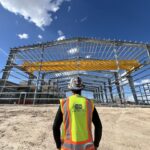Insulated metal panels (IMPs) are lightweight composite exterior wall and roof panels with metal skins and an insulating foam core. Available in a wide variety of colors, widths, profiles and finishes, IMPs enable virtually any aesthetic desired for walls and roofs.
IMPs are overcoming resistance and restrictions to realize results

Photo courtesy of Green Span Profiles
According to Jeff Irwin, executive director of the Metal Construction Association’s IMP Funders Group, their superior insulating properties, outstanding spanning capabilities and one-pass installation make them quick to install,saving costs compared to other wall assemblies.
However, in spite of IMPs’ attributes, some communities, architectural review boards (ARBs) and design review committees (DRCs) may not allow IMPs to be installed on new or existing buildings. Building ordinances can be written to limit and prohibit very specific building material choices—oftentimes IMPs.
“Most municipalities object to the metal building look because they see it as cheap and unappealing,” says Brian N. Jaks, PE, vice president of sales and marketing, Green Span Profiles, Waller, Texas. “I believe this is because of the ribs and exposed fasteners of single-skin cladding. Most IMPs have neither exposed fasteners, nor ribs and therefore give a cleaner more pleasing aesthetic.
Some, if not all, municipalities like the look of precast concrete because they view it as durable, expensive and sound. The heavy embossment pattern of IMPs gives the same look without the exorbitant price and labor. Also, concrete has no insulating value and IMPs are nominally R-8 per inch of insulation thickness.”
Brian Ng, PE, LEED AP, technical director at All Weather Insulated Panels, Vacaville, Calif., explains that IMPs have historically been used in a niche market and primarily for the cold-storage industry. “IMPs have only started to gain popularity in recent years due to stricter energy codes and sustainability awareness. There is no section in the building code written specifically for IMPs, so acceptance of the product faces its challenges.”

Photo courtesy of MBCI
Antiquated Misperceptions
Part of the reason for IMP pushback is found in the origin of metal construction panels. Building ordinances were largely berthed in the 1960s when metal panels were mostly limited to through fastener (barn) style panels and some standing seam roofs. Some felt straight metal panels were not necessarily as pleasing to the eye as wood shake, tile or slate roofing, and many preferred their look and resale value. Ironically, today many of these non-metal building materials installed in the 1960s have badly deteriorated.
While IMP restrictions have their roots in antiquated misperceptions, these IMP-restrictive policies still exist all over North America. Irwin believes there are no performance limitations that the IMP Funders Group is aware of that would limit the use of IMP (or for that matter any metal-faced panel) other than a desire to have a non-metal look. “In our opinion, it is all about a certain look that a developer or jurisdiction is looking for,” he explains. “The only limitation that we have run across is purely the aesthetic look that the owner is looking for. An example would be a smaller community in Colorado that was looking to construct a new building in an area that was dominated (and in fact restricted) to only wood-sided structures.”
Eric Pittman, general manager of IMP sales at Houston-based MBCI, agrees that restrictions occur when IMP panels cannot provide the desired particular visual appeal desired, in addition to a lack of understanding of the product. He also cites poor history of prior projects that utilized IMPs, product cost, severe wind loading or other localized weather-related code requirements where IMP panels cannot meet standards established.

Photo courtesy of Metl-Span
Joe Calsada, business development manager at Metl-Span, Lewisville, Texas, believes, “Most of the roadblocks concerning IMPs come about because someone doesn’t understand the product. If the issues are aesthetic, then providing case studies and photography to combat preconceived ideas of what IMPs look like in relation to other cladding systems are very useful.”
Another misconception about IMPs leading to restrictions is that once damaged, they are unsightly and can’t be repaired. Irwin says one of the primary visual benefits to using IMPs is the large, flat surfaces that can be achieved with very few seams or joints. However, “Any time that large surface is significantly damaged, it will most likely stand out for certain colors and non-textured panels,” he explains.
“IMPs have the advantage of an optional surface texture which would help to hide a certain level of surface damage. If the panel is damaged beyond that level, there is most likely some performance issues that could be compromised (insulation, structural, etc.).” Pittman contends there are many options for IMP repair and the misperception that concealed fastener products are not replaceable is usually at the source of the confusion.
Paul Collyer, vice president of business development at Metl-Span, says repairing damaged IMPs is not as complex as many people think. “There are several common repair methods used depending on the extent of the damage,” he says. “For surface scratches, the important thing is to match the repair paint resin as closely as possible to the original roll coated finish. Small dents can sometimes be repaired by a local auto body shop using similar repair methods as with automobiles.
Larger dents are often repaired using a single skin overlay of matching sheet metal. Horizontal panels can also be replaced without unzipping the entire wall. This process involves removing the panels above the damaged panel from top to bottom—opposite direction of the original installation.”

Photo courtesy of Metl-Span
IMP Disguise
To comply with ordinances against IMPs, many IMP manufacturers are disguising their panels with factory-applied finishes and coatings applied to their exterior face. Pittman contends these coatings are standardized in the industry and they may resolve issues related to painted metal exterior product restrictions. “Coatings and textures vary from manufacturer to manufacturer but remain a viable alternative to offset the ‘no-metal-panel exterior’ limitations,” he says.
Ng says elastomeric coatings may be field or factory applied to the exterior face of IMPs to create a stucco-style texturing of the panels.
“Some manufacturers may offer a textured profile in a matte paint finish to resemble a stucco look without any additional applications of elastomeric IMPs are overcoming resistance and restrictions to realize results finishes.” Irwin says IMP panels can have a formed surface embossed into the face sheet to give them some dimensionality. “It is also possible to apply a film or directly apply other finishes that provide a variety of finish appearances such as wood, stucco or brick,” he adds.
Drew Snoply, business development manager at Metl-Span, says the texture application fully bonds to the surface and results in a very durable, long-lasting aesthetic finish. “These textures are available in an array of colors both standard and custom. They provide an additional aesthetic option in an already full pallet of profiles, colors and modules within the IMP portfolio.”
Get Help
To learn more about overcoming objections to IMPs, Pittman suggests consulting IMP manufacturers. “Websites have improved to be more informative as well,” he adds. Irwin suggests visiting the Insulated Metal Panel Funders Group at www.metalconstruction.org/insulated-metal-panels.
Additionally, Collyer agrees that IMP manufacturers can provide a wealth of information enabling architects and design/build contractors to contest an initial rejection of the product on aesthetic grounds. “It usually comes down to educating these boards using case studies, photographs, product samples and yes, sometimes live product presentations,” he says. “Many of the people making these decisions are not familiar with IMPs and providing them with attractive examples of prior use of the product is enough for them to change their minds.”





